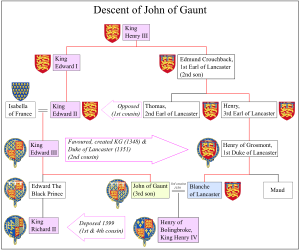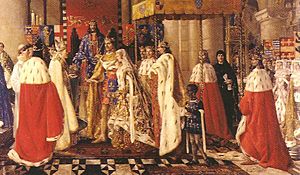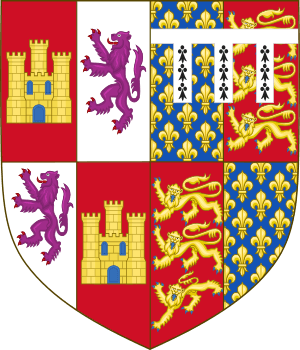John of Gaunt facts for kids
Quick facts for kids John of Gaunt |
|
|---|---|
| Duke of Lancaster | |
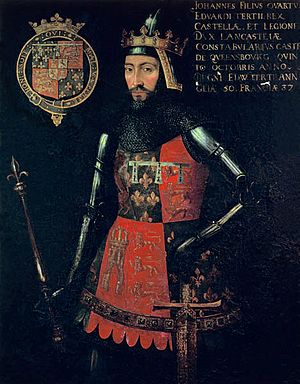
A portrait commissioned in c. 1593 by Sir Edward Hoby for Queenborough Castle, Kent, probably modelled on Gaunt's tomb effigy in Old St Paul's Cathedral. His tabard shows the royal arms of Castile and León impaling his differenced Plantagenet arms, while on the shield Castile and León is shown as an inescutcheon of pretence, representing his claim to that kingdom by right of marriage to Constance of Castile.
|
|
| Duke of Aquitaine (as John II) | |
| Reign | 2 March 1390 – 3 February 1399 |
| Predecessor | Richard II |
| King of Castile (claimant) | |
| Claimed | 29 January 1372 – 8 July 1388 |
| Born | 6 March 1340 Saint Bavo's Abbey, Ghent, Flanders |
| Died | 3 February 1399 (aged 58) Leicester Castle, Leicestershire, Kingdom of England |
| Burial | 15 March 1399 St Paul's Cathedral, London |
| Spouses |
|
| Issue more... |
|
| House |
|
| Father | Edward III, King of England |
| Mother | Philippa of Hainault |
| Military career | |
| Allegiance | |
| Service | 1367–1388 |
| Conflicts |
|
John of Gaunt, Duke of Lancaster (born March 6, 1340 – died February 3, 1399) was an important English prince, military leader, and politician. He was the third son of King Edward III of England. He was also the father of Henry IV, who later became king.
Because of his royal family, good marriages, and large land gifts, John of Gaunt was one of the richest people of his time. He was very powerful during the reigns of both his father and his nephew, Richard II. He founded the royal House of Lancaster, which would later rule England. He got his name "Gaunt" from his birthplace, Ghent in Flanders.
John spent his early career fighting in France and Spain during the Hundred Years' War. He tried to claim the throne of Castile through his second wife, Constance of Castile. For a while, he even called himself the King of Castile. When his older brother, Edward the Black Prince, became too sick to rule, John took over many government duties. He became one of the most powerful people in England.
He faced challenges in wars abroad and political problems at home. His disagreements with the English Parliament and other powerful people made him unpopular for a time. John had a lot of influence over the English throne when King Richard II was young. He helped settle arguments between the king and a group of rebellious nobles, which included his own son, Henry Bolingbroke.
After John died in 1399, his lands and titles were taken by the Crown. His son Henry was exiled. But Henry soon returned to reclaim what was his and removed Richard from the throne. Henry then became King Henry IV of England (1399–1413). He was the first of John of Gaunt's descendants to become King of England.
All English monarchs from Henry IV onwards are related to John of Gaunt. His direct male family line, the House of Lancaster, ruled England from 1399 until the Wars of the Roses. John also had five children outside of marriage. Four of them, known as the Beauforts, were with Katherine Swynford, who later became his third wife. These children were later made legitimate by royal and church decrees. Through his daughter Joan Beaufort, Countess of Westmorland, he was an ancestor of the Yorkist kings Edward IV, Edward V, and Richard III. Through his great-granddaughter Lady Margaret Beaufort, he was also an ancestor of Henry VII. Many royal families in Europe can trace their family lines back to John of Gaunt.
Contents
Early Life and Wealth
John was the third surviving son of King Edward III of England. His first wife, Blanche of Lancaster, was also his third cousin. They both shared a great-great-grandparent in King Henry III. They married in 1359 at Reading Abbey. This marriage was part of King Edward III's plan to connect his sons with rich heiresses.
When Blanche's father, the Duke of Lancaster, died in 1361, John received half of his lands. He also gained the title "Earl of Lancaster." This made him the biggest landowner in Northern England. He inherited the rest of the Lancaster property when Blanche's sister died in 1362.

John received the title "Duke of Lancaster" from his father on November 13, 1362. By then, he owned at least thirty castles and estates across England and France. He had a large household, similar to a king's. He owned land in almost every county in England. This brought him a huge income, making him incredibly wealthy.
Military Leadership
John of Gaunt was one of England's main military commanders in the 1370s and 1380s. However, his military efforts did not have the same shining success as his older brother, Edward the Black Prince.
War in France
When the war with France started again in 1369, John was sent to Calais. He led a small English army to raid northern France. In August, he faced a much larger French army. John decided not to attack such a strong force. The two armies faced each other for weeks until the English received more soldiers. The French then left without fighting.
John and his allies then tried to attack Harfleur, a French naval base. They marched on Harfleur but were slowed down by French attacks. John besieged the town for four days in October. But he was losing too many men to sickness. He decided to give up the siege and return to Calais. During this retreat, his army had to fight its way across the Somme River. By mid-November, the remaining soldiers returned to Calais. Even though the campaign seemed unsuccessful, John had forced the French king to cancel his plans to invade England that autumn.
In 1370, John was sent to Aquitaine to help his sick older brother, the Black Prince. He took part in the Siege of Limoges in September 1370. He led the siege operations and even fought hand-to-hand in the tunnels. After this, the Black Prince made John the leader of Aquitaine. John tried to defend the area from French attacks for almost a year. But he lacked money and supplies. He could only protect the small areas the English still held. He resigned his command in September 1371 and returned to England.
Just before leaving Aquitaine, he married Infanta Constance of Castile in September 1371. The next year, he tried to invade France with his father, Edward III. But bad winds stopped their large army for three months.
John's most famous military action happened from August to December 1373. He led about 9,000 mounted soldiers from Calais on a long raid through France. This four-month journey through enemy territory was a bold move. But it achieved almost nothing. His army faced French ambushes and suffered from disease and starvation. They plundered the countryside, which caused temporary damage to French resources. But it did not have lasting military value. Many soldiers and horses died from cold, disease, or hunger. The army reached English-held Bordeaux in December 1373. They were severely weakened, having lost at least two-thirds of their force. Many more died from the plague in Bordeaux. The army was too sick and tired to defend Aquitaine. Soldiers began to leave. John had no money to pay them. So, in April 1374, he gave up and sailed home.
John's last campaign in France was in 1378. He planned a large expedition to take control of Brittany. But there were not enough ships for the horses. So, the goal changed to capturing St. Malo. The English destroyed ships in St. Malo harbor and began to attack the town. But John's large army struggled to find food. French armies harassed his forces. In September, the siege was abandoned. The army returned to England without success. John of Gaunt received most of the blame for this failure.
Because of these failures, John was one of the first important English figures to believe that the war with France could not be won. France had more money and soldiers. He started to suggest peace talks. He became known for trying to make peace. This made him unpopular when most Englishmen still thought victory was possible.
Political Influence and Challenges
After his older brother, Edward the Black Prince, died in 1376, John of Gaunt became more powerful. He tried to protect the religious reformer John Wycliffe. This was possibly to balance the growing power of the church. However, John's rise to power happened when many people disliked his influence. English forces were losing battles in the Hundred Years' War. King Edward III's rule was also becoming unpopular due to high taxes. People linked John of Gaunt to the failing government of the 1370s. Unlike the popular King Edward and the Black Prince, John had not won great military fame. This hurt his public image.
When Edward III died in 1377, John's ten-year-old nephew, Richard II of England, became king. John's influence grew even more. But people still mistrusted him. Some even thought he wanted to take the throne for himself. John worked hard to show he was loyal to Richard. As the unofficial ruler during Richard's youth, John made some unpopular decisions about taxes. These led to the Peasants' Revolt in 1381. During this revolt, rebels destroyed his home in London, the Savoy Palace. John was away from London during the uprising. This helped him avoid the rebels' direct anger.
In 1386, John left England to pursue his claim to the Crown of Castile. He claimed the throne through his second wife, Constance of Castile. But a crisis quickly began in England while he was away. In 1387, King Richard's poor rule almost led to a civil war. John had to give up his plans in Spain and hurry back to England in 1389. Only John's help in the political crisis convinced the nobles and King Richard to reach an agreement. This brought a period of peace. In the 1390s, John's reputation for caring about the kingdom was largely restored.
Marriages and Family Life
John was married three times.
- His first wife was Blanche of Lancaster. They were third cousins. They married in 1359 at Reading Abbey. They had seven children, but only three lived to adulthood. Blanche died in 1368.
- After Blanche's death, John married Infanta Constance of Castile in 1371. She was the daughter of King Peter of Castile. This marriage gave John a claim to the throne of Castile. They had one daughter. Constance died in 1394.
- During his second marriage, John had a relationship with Katherine Swynford. She was the daughter of a knight. They had four children together. All of them were born before their parents married. The relationship lasted until 1381, when it ended for political reasons.
On January 13, 1396, two years after Constance died, Katherine and John of Gaunt married in Lincoln Cathedral. Their children were given the last name "Beaufort." These children were made legitimate by royal and church decrees after John and Katherine married. However, a later rule said they could not inherit the throne.
Relationship with Geoffrey Chaucer
John of Gaunt was a supporter and close friend of the poet Geoffrey Chaucer. Chaucer is famous for his work The Canterbury Tales. Near the end of their lives, John and Chaucer became brothers-in-law. Chaucer married Philippa de Roet in 1366. John married Katherine Swynford (de Roet), who was Philippa Chaucer's sister, in 1396. Even though Philippa died around 1387, the men were connected as family. John's children with Katherine were Chaucer's nephews and niece.
Chaucer's poem The Book of the Duchess was written to remember Blanche of Lancaster, John of Gaunt's first wife. The poem uses a story to talk about John and Blanche. It describes a "long castel with walles white" who is sad after his love, "good fair White," dies. "Long castel" refers to Lancaster. "Walles white" likely refers to Blanche. "Seynt Johan" was John of Gaunt's patron saint. "White" is the English translation of "blanche." These clues show that the sad knight in the poem is John of Gaunt.
Chaucer's short poem Fortune, written in the 1390s, is also thought to be about John of Gaunt. In the poem, Chaucer complains to "Fortune." He says he has learned about his enemies through her unfairness. "Fortune" replies that she has been kind to him. She says he still has his "best friend alive." This "best friend" is believed to be John of Gaunt. The poem shows Chaucer's deep appreciation and affection for John of Gaunt.
Death and Burial
John of Gaunt died of natural causes on February 3, 1399. He passed away at Leicester Castle, with his third wife Katherine by his side.
He was buried next to his first wife, Blanche of Lancaster. Their tomb was in the choir of St Paul's Cathedral in London. Their beautiful tomb was built between 1374 and 1380. The two statues on the tomb were special because their right hands were joined. The monument was badly damaged and possibly destroyed during a period of English history called the Interregnum (1649–1660). Anything that survived was lost in the Great Fire of London in 1666. A memorial in the crypt of the current cathedral lists Gaunt's as one of the important lost monuments.
Family Connections
Marriages
- On May 19, 1359, at Reading Abbey, John married his third cousin, Blanche of Lancaster. She was the younger daughter of Henry of Grosmont, Duke of Lancaster. They both shared a common ancestor in King Henry III. The wealth Blanche brought to the marriage was the start of John's fortune. Blanche died on September 12, 1368. Their son Henry Bolingbroke became Henry IV of England. Their daughter Philippa of Lancaster became Queen of Portugal. All later kings of Portugal are descended from John of Gaunt.
- In 1371, John married Infanta Constance of Castile. She was the daughter of King Peter of Castile. This marriage gave John a claim to the throne of Castile. Although John never fully claimed the throne, his daughter with Constance, Catherine of Lancaster, became Queen of Castile. Catherine of Aragon is descended from this family line. Constance died in 1394.
- During his marriage to Constance, John of Gaunt had four children with his mistress, Katherine Swynford. Katherine's sister, Philippa Roet, was married to Geoffrey Chaucer.
- John married Katherine in 1396. Their four children, the Beauforts, were made legitimate by King Richard II and the Church. However, they were not allowed to inherit the throne. From their eldest son, John, came a granddaughter, Lady Margaret Beaufort. Her son, who later became King Henry VII of England, did claim the throne.
Children
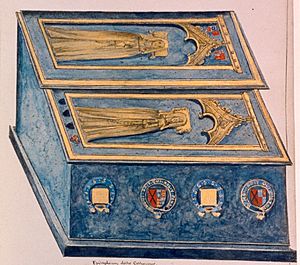
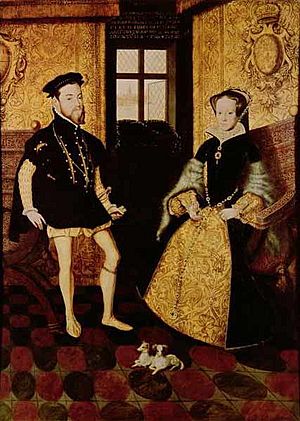
- By Blanche of Lancaster:
- Philippa (1360–1415) married King John I of Portugal.
- John (1362–1365) was the first son of John and Blanche. He died young.
- Elizabeth (1364–1426) married three times.
- Edward (1365) died within a year of his birth.
- John (1366–1367) died young.
- Henry IV of England (1367–1413) married twice.
- Isabel (1368–1368) died young.
- By Constance of Castile:
- Catherine (1373–1418) married King Henry III of Castile.
- John (1374–1375) died young.
- By Katherine Swynford (children made legitimate in 1397):
- John Beaufort, 1st Earl of Somerset (1373–1410). His great-grandson was Henry VII of England.
- Cardinal Henry Beaufort, Bishop of Winchester (1375–1447).
- Thomas Beaufort, Duke of Exeter (1377–1427).
- Joan Beaufort (1379–1440) married twice.
- By mistress Marie de St. Hilaire:
- Blanche (1359–1388/1389) married Sir Thomas Morieux and had no children.
Titles and Symbols
Titles and Styles
- Earl of Richmond: Given to him as a baby in 1342.
- Earl of Leicester, Earl of Lancaster, Earl of Derby: Inherited in 1362 after his first wife's father died.
- Duke of Lancaster: Given to him on November 13, 1362.
- King of Galicia, King of Castile, King of León: Claimed in 1372 through his second marriage. This claim was not widely recognized.
- Duke of Aquitaine (1390–1399): Given to him for life in 1390 by his nephew, King Richard II of England.
Coat of Arms
As a son of the king, John used the royal coat of arms of England. These arms were changed slightly to show he was a younger son.
When he claimed the throne of Castile and León in 1372, he combined their arms with his own. The arms of Castile and León were on the left side of the shield (as you look at it). His English royal arms were on the right. In 1388, when he gave up his claim, he switched the sides. This still showed his connection to the Castilian royal family but meant he no longer claimed the throne.
John also had another coat of arms. It was black with three white ostrich feathers. This was similar to his brother, the Black Prince's, arms. It might have been used in jousting tournaments.
Legacy and Famous Mentions
John of Gaunt is a character in William Shakespeare's play Richard II. Before he dies, he gives a famous speech about England. He is also mentioned by the character Falstaff in Henry IV Part I.
The town of Hungerford in Berkshire has old ties to the Duchy of Lancaster. The manor became part of John of Gaunt's estate in 1362. Today, the John O'Gaunt Inn and the John O'Gaunt School in Hungerford are named after him. It is a tradition for residents to toast "The Queen, the Duke of Lancaster."
The John of Gaunt School in Trowbridge, Wiltshire, is built on land he once owned.
Family Tree
| Ancestors of John of Gaunt | ||||||||||||||||||||||||||||||||||||||||||||||||||||||||||||||||||||||||||||||||||||||||||||||||||||||||||||||||||||||||||||||||||||||||||||||||||||||||||||||||||||||||||||||||||||||||||||||||||||||||||||||||||||||||||||||||||||||||||||||||||||||||||||||||||||||||||||||||||||||||||||||||||||||||||||||||||||||||||||||||||||||||||||||||||||||||||||||||||||||||||||||||||||||||||||||||||||||||||||||||||||||||||||||||||||||||||||||||||||||||||||||||||||||||||||||||||||||||||||||||||||||||||||||||||||||||||||||||||||||||||||||||||||||||||||||||||||||||||||||||||||||||||||||||||||||||||||||||
|---|---|---|---|---|---|---|---|---|---|---|---|---|---|---|---|---|---|---|---|---|---|---|---|---|---|---|---|---|---|---|---|---|---|---|---|---|---|---|---|---|---|---|---|---|---|---|---|---|---|---|---|---|---|---|---|---|---|---|---|---|---|---|---|---|---|---|---|---|---|---|---|---|---|---|---|---|---|---|---|---|---|---|---|---|---|---|---|---|---|---|---|---|---|---|---|---|---|---|---|---|---|---|---|---|---|---|---|---|---|---|---|---|---|---|---|---|---|---|---|---|---|---|---|---|---|---|---|---|---|---|---|---|---|---|---|---|---|---|---|---|---|---|---|---|---|---|---|---|---|---|---|---|---|---|---|---|---|---|---|---|---|---|---|---|---|---|---|---|---|---|---|---|---|---|---|---|---|---|---|---|---|---|---|---|---|---|---|---|---|---|---|---|---|---|---|---|---|---|---|---|---|---|---|---|---|---|---|---|---|---|---|---|---|---|---|---|---|---|---|---|---|---|---|---|---|---|---|---|---|---|---|---|---|---|---|---|---|---|---|---|---|---|---|---|---|---|---|---|---|---|---|---|---|---|---|---|---|---|---|---|---|---|---|---|---|---|---|---|---|---|---|---|---|---|---|---|---|---|---|---|---|---|---|---|---|---|---|---|---|---|---|---|---|---|---|---|---|---|---|---|---|---|---|---|---|---|---|---|---|---|---|---|---|---|---|---|---|---|---|---|---|---|---|---|---|---|---|---|---|---|---|---|---|---|---|---|---|---|---|---|---|---|---|---|---|---|---|---|---|---|---|---|---|---|---|---|---|---|---|---|---|---|---|---|---|---|---|---|---|---|---|---|---|---|---|---|---|---|---|---|---|---|---|---|---|---|---|---|---|---|---|---|---|---|---|---|---|---|---|---|---|---|---|---|---|---|---|---|---|---|---|---|---|---|---|---|---|---|---|---|---|---|---|---|---|---|---|---|---|---|---|---|---|---|---|---|---|---|---|---|---|---|---|---|---|---|---|---|---|---|---|---|---|---|---|---|---|---|---|---|---|---|---|---|---|---|---|---|---|---|---|---|---|---|---|---|---|---|---|---|---|---|---|---|---|---|---|---|---|---|---|---|---|---|---|---|---|---|---|---|---|---|---|---|---|---|---|---|---|---|---|---|---|---|---|---|---|---|---|---|---|---|---|---|---|---|---|---|---|---|---|---|---|---|---|---|---|---|---|---|---|---|---|---|---|---|---|---|---|---|---|---|---|---|---|---|---|---|---|---|---|---|---|---|---|---|---|---|---|---|---|---|---|---|---|---|---|---|---|---|---|---|---|---|---|---|---|---|---|---|---|---|
|
||||||||||||||||||||||||||||||||||||||||||||||||||||||||||||||||||||||||||||||||||||||||||||||||||||||||||||||||||||||||||||||||||||||||||||||||||||||||||||||||||||||||||||||||||||||||||||||||||||||||||||||||||||||||||||||||||||||||||||||||||||||||||||||||||||||||||||||||||||||||||||||||||||||||||||||||||||||||||||||||||||||||||||||||||||||||||||||||||||||||||||||||||||||||||||||||||||||||||||||||||||||||||||||||||||||||||||||||||||||||||||||||||||||||||||||||||||||||||||||||||||||||||||||||||||||||||||||||||||||||||||||||||||||||||||||||||||||||||||||||||||||||||||||||||||||||||||||||
See also
 In Spanish: Juan de Gante para niños
In Spanish: Juan de Gante para niños


